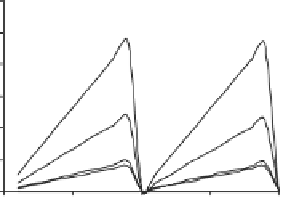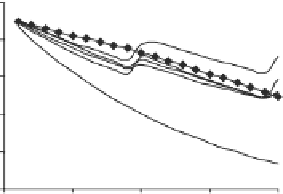Agriculture Reference
In-Depth Information
60
60
50
56
40
52
30
48
20
44
10
40
0
0
5
10
15
20
0
5
10
15
20
Year
Ye ar
IM P LUS
F P LUS
TIM P LUS
IM P LUS
F P LUS
TIM P LUS
T C LUS
TC S F LUS
TP LUS
TC LUS
TCSFLUS
TP LUS
Fig. 14.4
Predicted carbon stocks in above-ground biomass and soil (t ha
-1
) over time of alterna-
tive land use systems, Claveria, Misamis Oriental, The Philippines
produced the highest accumulated biomass carbon because of the fast growth of
timber species being planted and the entire system area was devoted to timber
species whereas only 40 percent in TCSFLUS and 15 percent for both TIMPLUS
and TCLUS systems were planted to timber species (Appendix 3). On the other
hand, the predicted annual biomass carbon under IMPLUS and FPLUS systems
was zero throughout the simulation period, since the annual harvesting of above-
ground biomass has been specified on these systems and hence, plant carbon was
reduced to zero at the end of each year.
Simulation results of the changes in soil carbon showed that predicted total soil
carbon decreased throughout the simulation period for all land use systems
(Fig. 14.4). The slowest rate of reduction in total soil carbon was in the timber
plantation system (TPLUS), with only a seven percent reduction over 20 years.
Current farmers' practice of maize cropping (FPLUS) had the highest rate of soil
carbon reduction, amounting to a 26 percent reduction of the initial total soil carbon
content. The predicted decline in total soil carbon under tree-based land use sys-
tems was influenced by the interaction of soil erosion and organic matter recycling.
The level of soil carbon was sustained under TPLUS systems because soil loss was
low while the amount of organic matter recycled was high.
The severe soil loss under FPLUS system could have resulted in a sharp decline
in soil carbon over time. It is also interesting to note that the level of total soil car-
bon under TPLUS system was lower than those under IMPLUS system during the
first nine years of the simulation period. This is because systems with steadily
growing trees may have had a greater loss of carbon from the soil to support the
increasing standing biomass (Young et al. 1998). As a result, the average total soil
carbon under tree-based land use systems (53.4-54.9 t ha
−1
) was almost similar to
those under IMPLUS system (54.2 t ha
−1
) (Appendix 3).





































































































































Search WWH ::

Custom Search